The History of the Concept of Modifiable Synapses
Caleb Bevan
Objective 1: Describe the historical perspective underlying our understanding of modifiable synapses.
As of the early part of the 20th century, there was really good evidence that learning and memory systems would be located in a single brain region. After all, Phineas Gage’s unfortunate accident (as described by Harlow) had shown convincingly that something as complex as human emotion resided in a limited area of the brain, namely the prefrontal cortex. Paul Broca had characterized Broca’s area, and showed that the complexity of human language production was in an even smaller area of cortex. All the major sensory and motor systems had been localized to a part of cortex as described in Korbinian Brodmann’s famous map, and there were still plenty of the 48 Brodmann’s areas in human cortex that had still not been identified with a single function in lesion studies.
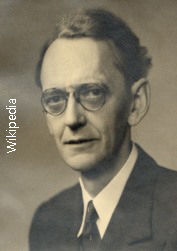 With characteristic hubris, early 20th century neuroscientists named the concept before they found it. Richard Semon coined the German term Engramm, which became engram in English, based on the conception that learning and memory are “written on the brain”. (Semon’s hubris came to a particularly tragic end and he is now mostly forgotten.)
With characteristic hubris, early 20th century neuroscientists named the concept before they found it. Richard Semon coined the German term Engramm, which became engram in English, based on the conception that learning and memory are “written on the brain”. (Semon’s hubris came to a particularly tragic end and he is now mostly forgotten.)
A Harvard psychologist named Karl Lashley set out to find the location of learning and memory systems in the brain. His preferred model system was to use rodents in a maze, a method pioneered by Edward Tolman. Lashley’s contribution was to ablate different regions of the rat brain and then test them on a maze to see the effect on the rat’s ability to locate a reward at the end of a maze. Lashley found that it didn’t matter which brain area was removed; what mattered was how much of the brain was removed. His attempt to locate the engram had ended in failure (or so it was believed). 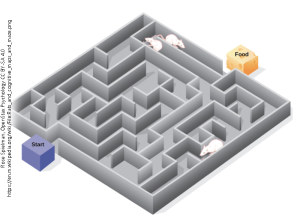 Now Tolman’s maze exists only as a meme in the public imagination, but a modified version is still used in studies of the hippocampus, an area of the brain which contains place cells, neurons that code for the location of the animal. As we will see, the hippocampus is also the site of critical processes in learning and memory. Although not realized at the time, the work of Lashley was instrumental in helping us understand how these place cells have been adapted to encode what neuropsychologists call declarative memory — memory for facts, dates, and events, and the kind of memory you will use when you take an exam on this material.
Now Tolman’s maze exists only as a meme in the public imagination, but a modified version is still used in studies of the hippocampus, an area of the brain which contains place cells, neurons that code for the location of the animal. As we will see, the hippocampus is also the site of critical processes in learning and memory. Although not realized at the time, the work of Lashley was instrumental in helping us understand how these place cells have been adapted to encode what neuropsychologists call declarative memory — memory for facts, dates, and events, and the kind of memory you will use when you take an exam on this material.
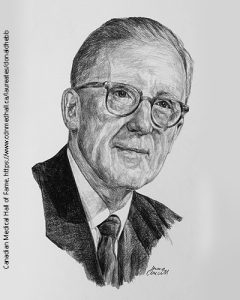 In 1949, Donald Hebb published a monograph (i.e. long paper; short book) entitled The Organization of Behavior: A Neuropsychological Theory. This is one of those books that everyone makes reference to but very few have read. Through some difficult passages, the upshot of Hebb’s monograph was an explosive idea: maybe we were all looking for the wrong thing in our search for the engram. Maybe it’s not a place, but rather a process, that we should be looking for.
In 1949, Donald Hebb published a monograph (i.e. long paper; short book) entitled The Organization of Behavior: A Neuropsychological Theory. This is one of those books that everyone makes reference to but very few have read. Through some difficult passages, the upshot of Hebb’s monograph was an explosive idea: maybe we were all looking for the wrong thing in our search for the engram. Maybe it’s not a place, but rather a process, that we should be looking for.
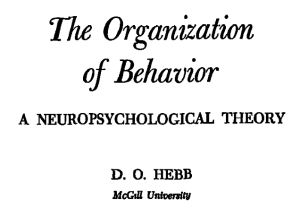 As often happens in science, it was both. The place is the hippocampus; the process is what has come to be known as a Hebbian synapse in Hebb’s honor. A Hebbian synapse is one where the information transfer function we discussed earlier is not constant.
As often happens in science, it was both. The place is the hippocampus; the process is what has come to be known as a Hebbian synapse in Hebb’s honor. A Hebbian synapse is one where the information transfer function we discussed earlier is not constant.
Rather, the more a Hebbian synapse is used, the easier it is to operate. A common analogy is to equate the Hebbian synapse to a door with a rusty hinge. The more we swing the door back and forth, the easier it is to operate. Transferring information in a Hebbian synapse is difficult at first, but the more it is operated, the easier it is to operate so by the end of the process, a Hebbian synapse transfers information much more easily than when we started.
Before Lashley joined the Harvard faculty, and Hebb suffered the death of his wife in a car accident and was rethinking his scientific career, a seemingly insignificant event happened to a young boy named Henry Molaison. Henry had a bicycle accident in 1933 at the age of 7. Gradually, over a period of years, the effects of the bicycle accident manifested themselves as increasing seizure activity. By 27, he was experiencing episodes of status epilepticus, a life-threatening medical condition.
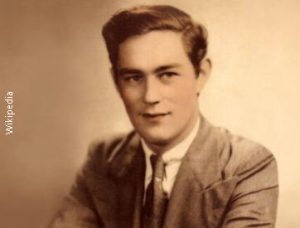 His seizures could no longer be controlled by medication and then (as now) brain surgery was the only option. His family found their way to a Connecticut neurosurgeon named William Scoville. Scoville determined that the seizures were being triggered (kindled) in a part of the brain called the hippocampus; in Henry Molaison’s case, the seizures had started in one hippocampus and traveled to the hippocampus on the other side. Both hippocampus’s were irretrievably damaged by this abnormal electrical activity and were threatening the rest of Henry’s brain. They needed to be removed.
His seizures could no longer be controlled by medication and then (as now) brain surgery was the only option. His family found their way to a Connecticut neurosurgeon named William Scoville. Scoville determined that the seizures were being triggered (kindled) in a part of the brain called the hippocampus; in Henry Molaison’s case, the seizures had started in one hippocampus and traveled to the hippocampus on the other side. Both hippocampus’s were irretrievably damaged by this abnormal electrical activity and were threatening the rest of Henry’s brain. They needed to be removed.
The surgery was successful in the sense that Henry Molaison’s seizures abated. Unfortunately for Henry, but fortunately for science, there was a terrible price paid for his survival: he lost the ability to form declarative memory. He still had procedural memory: he performed tasks such as drawing a star projected to him by a mirror, and by doing it over and over, he got really good at it. He had no retrograde amnesia: he could remember facts, dates, and events from his life before the surgery. He did have a severe anterograde amnesia: he could never remember his caregivers, or that he had even met them before. He was completely unable to form new declarative memories.
This shocking development caught the attention of Scoville, and he contacted a neuroscientist by the name of Brenda Milner. Milner was completing her PhD under Donald Hebb at McGill University in Montreal. She had studied two patients of Wilder Penfield with similar but less profound difficulties. (You may remember Wilder Penfield as the McGill surgeon who mapped out the sensory and motor homunculi of the human brain.) Scoville approached Penfield; Penfield sent Milner. She came to visit H.M. (as he was now known) and extensively studied his memory loss. Later studies by Suzanne Corkin added to our knowledge of H.M.’s condition so that H.M. became “the most studied individual in the history of neuroscience.” We now believe that the hippocampus plays a critical role in declarative memory by carrying out a process called consolidation: in a sense “packaging” the memory trace to the appropriate area of the cortex (e.g. visual cortex for a visual memory; auditory cortex for an auditory memory). While the hippocampus is not the location of the engram — the engram exists only at the molecular and cellular level, as a Hebbian synapse — it still plays a critical role in learning and memory and became the focus of neuroscientists studying learning and memory.
Media Attributions
- Photo of Karl Lashley © Harvard is licensed under a All Rights Reserved license
- Rats and cognitive maps and maze © Rose M. Spielman, PhD is licensed under a CC BY (Attribution) license
- Donald Hebb is licensed under a All Rights Reserved license
- Hebb title page is licensed under a All Rights Reserved license
- Henry Gustav © Jim Fitzgerald is licensed under a Public Domain license

